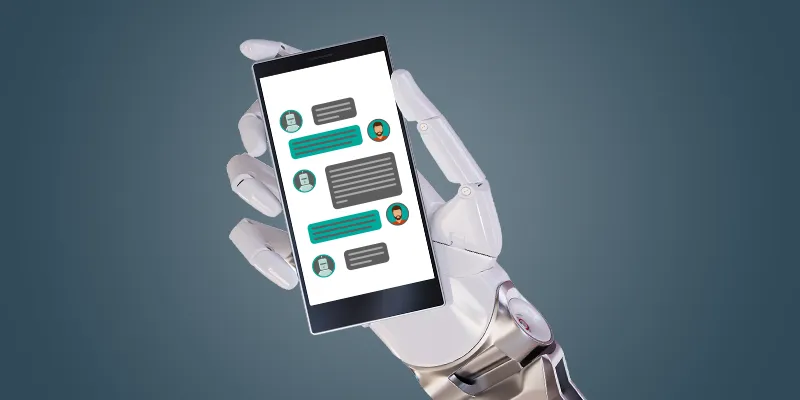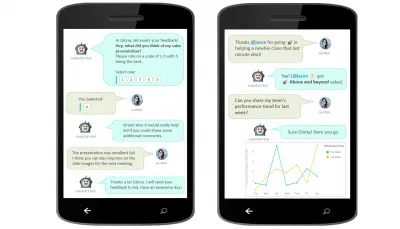Bots and artificial intelligence ‑ next wave of disruption in HR
Most enterprise businesses, for decades, have been subjected to tools that have bad user interface and complex designs. Apart from being boring and bulky, most of these tools require hours of training, onboarding, etc., before one can actually start using them. On an average, a typical employee ends up spending 70‑80 percent of their work time on outdated enterprise software. In this process, you eventually lose crucial work time in just figuring out the basic workflow. If the hours spent on enterprise software could be brought down without hampering the workflow, then it could be a huge boost in employee efficiency. There ought to be a better way for enterprise businesses to get work done quickly and efficiently. Bots might be the answer to this.

Simple and efficient bots
Both chatbots and artificial intelligence (AI) together form a small but significant step in revolutionising the way enterprise solutions are supposed to be ‑ simple, intuitive, and engaging. Bots have the ability to take away the challenges that come with accessing a new enterprise application by simplifying most of the use cases into user friendly interactions, which are not only effective but also a lot more fun. About 80 percent of businesses use some kind of a communication and collaboration platform on a daily basis. What makes bots special is that they can easily be integrated into some of the existing communication platforms used by businesses, in order to give an in-app experience to its users.
Typical enterprise business is comprised of a number of areas, but the one that is at the core of any business is HR or people management. HR as an industry has evolved tremendously in the last few years, but there has been little or no innovation in HR software. HR is a huge space with sections like recruitment, performance management, employee engagement, administration, compensation, and benefits. Let's take performance management as an instance, and see how bots can really simplify the whole process.
Stale annual performance reviews
Annual performance reviews, the most difficult and important aspect of a manager's role, forms the biggest chunk of this performance management process. The whole process is too cumbersome and organisations end up spending weeks or even months conducting these reviews. Employees have to fill out long questionnaires, surveys, and forms as part of this process at the end of the year. The data that are captured during this process is never real-time and in most cases, ineffective. On an average, the productivity of an organisation goes down by 40 percent during this period as the whole workforce is pre-occupied in filling out forms instead of focussing on the tasks in hand.
Senior managers and HRs get affected the most as they have to spend another three to four weeks in going over the collected data and analysing them, resulting in massive loss of productivity. Organisations like General Electric, Accenture, Adobe, Google, and Eli Lilly are all getting rid of annual performance reviews since the data are expensive and not relevant as it is delivered quarterly or yearly. Case in point - Accenture, which spent $32 million alone last year on their annual performance management process, says: "The process is too heavy , too costly for the outcome, and the outcome is not that great." 58 percent of business and HR leaders say that the performance management solutions they currently use are ineffective, drives no results, and they lose crucial work time in the process.
Conversational interface at the core
There is a huge need for simple, automated, and AI powered solution in this industry which can facilitate real-time feedback collection, and that's where bots can add tremendous value. The conversational interface design of the bot makes it a perfect solution to quickly collect feedback from employees in the most transparent way possible. Instead of forms, employees share their feedback through chat, which has proven to be a very effective to ensure maximum participation from the millennial generation. The AI and machine learning capabilities built into bots help managers get valuable insights into employee's performance without spending months in going over each and every feedback message that is collected. The advancement in natural language processing technology combined with sentiment analysis can help managers find easy-to-miss patterns hidden deep inside the data, which in turn helps in better workforce management.

The above image shows an AI-powered assistant (bot) that automatically captures positive feedback from team conversations and encourages employees to share feedback with their peers based on the core values of the company. No filling out forms, no processes, no boring emails ‑ everything happens in real-time and inside a chat interface. The data captured are also delivered immediately to managers with an employee performance trend report. This simple change from the traditional approach can make an organisation efficient by 200 percent. At the same time, since it is a lightweight model, bots reduce the cost by as much as 90 percent as compared to the traditional approach. These numbers are a clear indication that traditional processes are waiting to get revolutionised with the advent of bots and AI.
What’s next
Performance management and employee engagement areas, the ones which we covered above, are definitely gaining tremendous value out of bots and AI. There are many such processes that can easily be simplified with the help of bots. For instance:
- Simplifying the recruitment process through AI – you just tell the bot about a position you want to hire and it will suggest the right candidate, help you chat with the candidate, and also interview the candidate in some cases.
- Managing expenses and payroll through a simple bot – no more filling out forms for recording conveyance charges, just tell the bot and it will get your charges approved from the manager.
- Managing the complete onboarding flow for the new hires through a bot interaction – send out important company information through chat interface and let the bot act as a FAQ where the new hire can get answers to any question they might have.
Less overhead for the HR and managers, more productivity for the organisation, and more engagement for the employees. That’s how bots and AI are making life simpler at workplace.
The possibilities are endless and the market is ripe for innovation. It would be really interesting to see how this space evolves in the coming years.
(Disclaimer: The views and opinions expressed in this article are those of the author and do not necessarily reflect the views of YourStory.)







